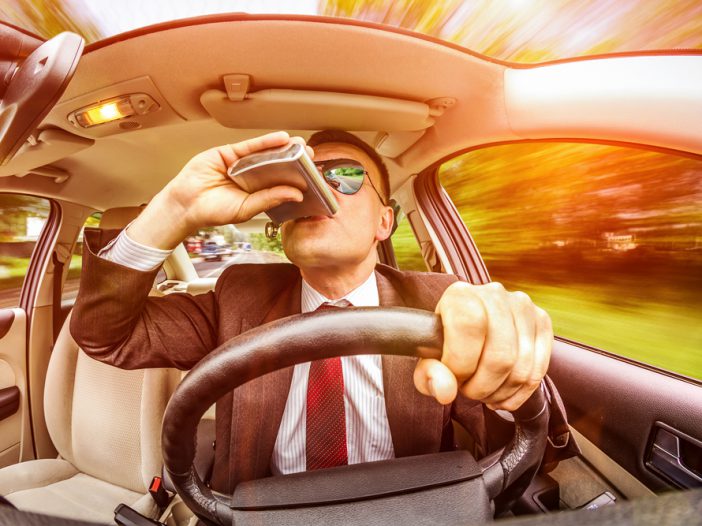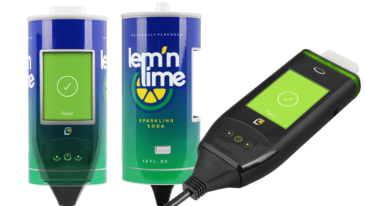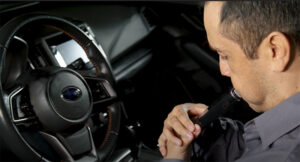
Drivers who are impaired by drugs or alcohol are not only a danger to themselves, but to others sharing the road. Drunk driving can lead to DUI charges, installation of a car breathalyzer, jail time, and even death to yourself or others. Unfortunately, in the case of alcohol-related accidents, quite often the drunk driver survives and the innocent victim doesn’t. According to a study conducted by the University of Illinois at Chicago, this is partly the result of alcohol’s relaxing effect on the body’s physiological response to trauma. Because of this possible danger, when you’re on the road, you need to be alert at all times.
Below, we’ll discuss the signs of impaired driving so that you know how to spot a drunk driver.
Stages of Impairment
Before we dive in, it’s important to first review the stages of alcohol impairment. This is important because an inebriated driver who’s just over the legal limit of a .08 BAC will be far harder to spot than a driver who has a blood alcohol content of .2. Naturally, as the blood alcohol content percentage grows, so too does the impairment of driving. This looks like:
- .0 – .05 BAC – Slight Impairment – A person will begin to have feelings of happiness, relaxation, and indolence.
- Slight impairment to speech, attention, coordination, memory, and balance.
- .06 – .15 BAC Moderate Impairment – A person will begin to feel intoxicated.
- Moderate impairment to driving, motor coordination, reaction time, judgment, balance, attention, memory, and speech.
- At this stage, their driving ability will be noticeably impacted and they may have trouble following the rules of the road.
- .16 – .3 BAC Severe Impairment – A person will have trouble remaining conscious and be visibly impaired.
- Significant impairment driving, motor coordination, reaction time, judgment, balance, attention, memory, and speech.
- At this stage, they are a severe danger and will very likely cause an accident or drive off the road.
How to Spot a Drunk Driver?
The common signs of drunk driving will be most noticeable in the severe impairment stage. There are 5 primary driving errors you should be on the lookout for. They are:
- Speed problems – Drunk drivers have difficulty judging speed and visual distance when driving. They may:
- Suddenly accelerate or decelerate as if they’re fanning the gas.
- Wildly fluctuating speeds.
- Excessive speeding, typically 15-20 miles per hour above the speed limit.
- Slow driving, typically 10 miles per hour below the speed limit.
- Braking problems – Drunk drivers may have problems with their ability to judge distances when stopping. This might manifest as:
- Stopping too far from the line or the curb
- Jerky stops
- Stopping too quickly
- Stopping at an odd angle
- Slamming on the breaks at the last minute to prevent an accident
- Issues driving within their lane – Drunk drivers commonly have trouble obeying the basic rules of the road, especially when it comes to lane control or lane changes. Common signs of this include:
- Weaving through traffic
- Ignoring lane lines to pass
- Drifting over traffic or lane lines and then suddenly re-correcting course
- Driving with a tire on or over the lane lines
- Striking or swiping parked or moving vehicles
- Making too wide a turn
- Driving on the wrong side of the road
- Swerving to straighten the vehicle
- Judgment impairment – When you’re driving, you’re subconsciously and consciously making calculations, judgments, and course corrections. When drunk, drivers tend to take far more risks than sober drivers. This could look like:
- Tailgating
- Changing lanes erratically
- Driving in an emergency lane
- Making illegal turns or U-turns
- Running traffic signals or ignoring road signs
- Driving off the road
- Lack of awareness – Drunk drivers have trouble processing information accurately and rapidly. As a result, their vigilance and awareness are severely diminished. Signs of this are:
- Driving without the headlights on
- Responding slowly to traffic lights
- Sitting at a stop sign and waiting for the “light to change”
- Driving in the wrong lane or the wrong way
- Stopping or slowing for no reason
- Using the wrong turn signal or neglecting to use the signal
What You Can Do?
There are five steps you need to take if you spot a drunk driver.
- Slow down and give them a wide berth; don’t attempt to pass them. The last thing you want is to become their victim in a crash.
- Call 911 and report a drunk driver.
- Give the location of the vehicle, the direction it’s traveling, make, model, and license plate (if you managed to grab it).
- Describe the signs of impaired driving that you noticed.
- Don’t follow the driver or attempt to stop him.
Once you’ve done these things, leave it up to the professionals to step in and detain the drunken driver.
Remember the Signs
Knowing the signs of drunk driving to identify a drunk driver could save your life and the lives of your passengers. It is vital that you remain vigilant and alert, especially late at night or early in the morning. If you’re worried that someone on the road is drunk, report them immediately. It’s far better to be safe than sorry.
Sources
Science Direct. Friedman, L. Science Daily. Does-Response Relationship Between In-hospital Mortality and Alcohol Following Acute Injury. (2012). https://www.sciencedirect.com/science/article/pii/S0741832912001528?via%3Dihub
California’s 2007 DUI enforcement Crackdown Report Spotting and Reporting Drunk Drivers Tip Sheet. https://www.abc.ca.gov/news/DUI_Prevention/Report_Drunk_Drivers_Tip_Sheet.pdf
DriversEd.com How to Recognize a Drunk Driver. https://driversed.com/driving-information/being-fit-to-drive/how-to-recognize-a-drunk-driver.aspx


